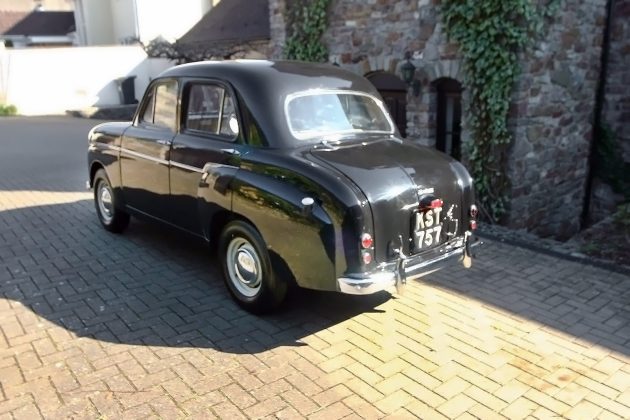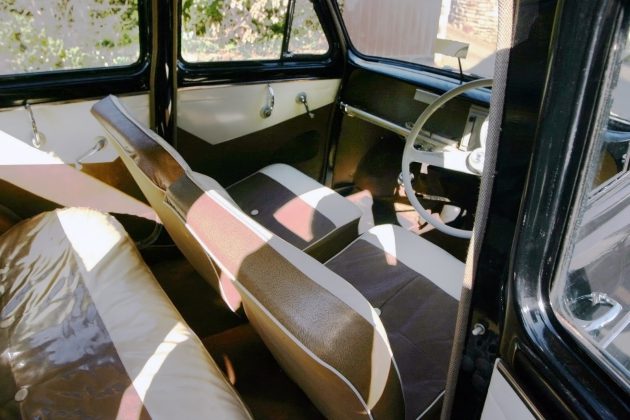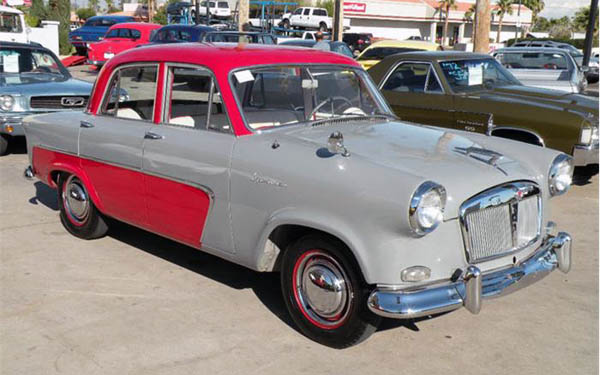Wow. Wow! This car has only traveled 497 miles since it was new! This 1957 Standard Ten is on eBay in Bristol, United Kingdom and it’s u.n.r.e.a.l. The seller is asking £8,950 ($12,862) for this museum piece and it’s a bargain at that price.
The Standard Motor Company made 172,500 Standard Ten models and I have no doubt that this is the finest original car left on the planet. The underside is just as amazing as the overside is.. or, I mean, the upperside.. Well, you know what I mean.. This car looks like it’s had a total restoration but you couldn’t restore a car like this for a figure even close to the asking price of this original car. The Ten was named for not its actual horsepower but for the surface area of the pistons as a way to figure taxation. In case any math majors are out there and wanted to know how it was figured, the Royal Automobile Club came up with this formula:  .
.
I wish the photos were better, it would help to see how great this car really is. This car is amazing, the plastic is still on the rear seats. Apparently, this car was purchased “new by Miss Isabella Johnston in Inverness who kept the car in her garage unused as she disliked driving but wanted to have it ‘just in case’.” It was then bought by a gentleman to display in his garage business after Miss Isabella Johnston’s passing and remained on display until 2011 when a respected auctioneer took possession of it after the contents of the gentleman’s garage business was liquidated. The “tool roll is in the unused boot with the jack still wrapped in brown paper and string!”
The Standard Ten actually had a 10 hp engine back towards the turn of the century, and then again in the 1930s, but this 1957 Standard Ten has a 948cc inline-four with a rousing 35 hp. A version of this car was sold in the US as a Triumph TR10 from 1957 to 1960. This car doesn’t have a fully-manual transmission, or a fully-automatic transmission, it has a Standrive! The seller explains it this way, “the car has a conventional gearbox in which the gears are selected by using the manual gear stick, there is no clutch pedal as it is engaged by pressing a button on the gear knob which via a valve and piston engages the drive by using the compression from the engine (No fluids involved).”
Our resident British car expert, Jamie, could probably add quite a bit of detail that I missed. Maybe he’ll chime in if he isn’t too embarrassed to be associated with the likes of me after my probably-incomplete explanation of this fantastic car! I would absolutely love to have this car but I’d want to drive it. It’s a double-edged sword: drive it or keep the miles ridiculously-low. As a somewhat famous playwright and poet once said, and I paraphrase, “To drive, or not to drive, that is the question..”.. What would you do?






Scotty, happy to chime in but there are commenters on our site (Andy, where are you?) that know more than I do. I’ve been lucky enough to be around some beautiful 10’s, but I have to admit none come close to this car. A lot of the engine/tranny ended up in our Heralds as well as the cut rate version of this car, the “Eight.”
The Standrive, however, was rare even when new. I’ve literally never seen a car with one in person. That alone would mean I’d have to drive it a little, just to experience it!
That’s one heck of a find!!! Thanks for writing it up!
I “kinda” saw one Standrive-equipped car in operation some 30 years ago; unfortunately, any use of that particular car was limited to quick parking lot demonstrations due to “propeller shaft” problems (long story). Interestingly enough here in the land of the automatic, a “Triumatic” (or possibly just “Trimatic”; depends on what literature you read) version of the Triumph 10 was planned, but I don’t believe it every actually happened.
Nice….what a cool little bugger that one is !
I’d drive it! Not much, but enough to have myself and anyone I know interested in the Standrive have the experience. Time capsule. Love it.
Clutch is vacuum operated, not compression.
Sorry to be so apparently cruel, but doesn’t this just make the mind wonder what happened here?
I can imagine the buyer bringing it home to his wife and saying to his wife – here you go Honey here’s your new car, only to be met with “I’m not driving that thing, where’s my MGA ?”
Sorry guys, by personal admission, I am not a Triumph fan, other than the TR6, which I thought was an beautiful piece of styling, and the Stag which I have always had a bit of a passion for, and the Chicane – again it was the styling. The rest are just plain silly. Just my personal taste please understand.
I suppose I will never get over the damage Triumph’s out of date engineering ideas did to the AH Sprite / MG Midget after the Leyland come together. The later versions of the car once Triumph got involved where just horrible.
It’s a curious survivor, but not one I would ever want leaving an oil spot on my garage floor.
Peter, I’m guessing you are not British. I’ve traveled there, and they have good public transport in the city, and an attitude that they can usually get there without motoring. They are different than Americans regarding motoring. And motorcar design. It is evolved from tractors and by golly, the tooling was paid for, might as well keep building it till they totally lose their part of the market.I liked early Sprites, as well, but they were already obsolete in the engine department when they came out, compared to a 283 Chevy, even in 1958. By 5 years later, other Americans were coming on board with modern, compact, powerful, oversquare engines. To blame Standard Triumph for the state of British engine design is misdirected.
It must be in the water. They all drank it.
The long-stroke/small-bore tendency had to do with the way cars were taxed in the UK at one point.
I’d be suspicion with the low mileage that the drive terrible.
Expensive cars belong to people who have multiple cars.
Not driving a Ferrari just means you won’t admit to your friends you prefer a big automatic floating boat and your not into cars anyway.
A car like this belonged to a working bloke, who may have baught this for his wife who wouldn’t drive it.
Sounds a lot like a VW Autostick but predates it by a decade. There was also something called a “Saxomat” made by Fitchel and Sachs (the clutch and shock people) of Germany that might be incorporated into it. Electric switch in the shift handle controlling a vacuum diaphram on the clutch fork. I thought they had a torque converter as well. Pretty good setup for someone with less than perfect left leg.
Al
Standard cars was a ok. Car, but oldscool. I have a Standard Vanguard Phase II fron 1954. It shared engine with thr gray Ferguson tractor. It drive ok. But is thursty.
The car itself doesnt drive so good as many other English cars, from the same period. Feels big and heavy.
It was not a best seller, so already from new, a rare car. At least outside UK.
But today its fun to own, and its ok. Relaible.
A old man i once met, said: Jesper why restore, such a tractor?? There was many better driving English cars, you could have choose.
Becourse i newer had seen such a car before. I see Minors all over, and dont want something every colekter have.
I have it since 2006 and payd 1000$ for it.
Hi, Jesper, thanks for sharing. I have a Standard Vanguard Sportsman (based on the series III Vanguard). I agree with your assessment of how they drive, but it sure is fun to have :-)
A. Vanguards weren’t sports cars (not even the “Sportsman” when you get right down to it); they were family cars. B. Ever driven the average American sedan of the period? Also not exactly sports car-like. ;)
In response to Andrew: No, indeed they were great wallowing tin whales. A 1955 Healy 100 or a Jag XK was from a different planet in handling, but a 1955 Olds sure would spin the tires!
Al
Peter P. I’m sorry that you didn’t read the story. No husband bought it for his wife. Miss Isabella bought it. A Miss does not have a husband.
Same clutching system my ’71 NSU 1200 “automatic” had – a large vacuum motor using engine vacuum was controlled by an electric valve actuated by a microswitch in the floorshift knob. Touch knob, car declutched, shift gears & release knob, clutch engaged. However, the NSU incorporated a torque converter, which meant you could leave the car in gear without declutching, at a stopsign, then just move off again. The TC smoothed out the shifts. I really enjoyed the clutchless floorshift, especially in traffic. It was the same as the VW Autobox, if the VW had the torque converter.
The wildest transmission I’ve ever seen is my ’61 Hillman Minx convertible with the “Easidrive” electric automatic. Using an Eaton USA developed system, the Easidrive had a 3 speed manual, coupled to a dual electromagnetic powder clutch, controlled by a speed governor driven off the trans, a special generator, and a “brain” consisting of 8 relays, resistors and a thermistor – all pre-transistor electricals. The car has a modified PRNDL column shift. You put it in D, and as you push the accelerator, the generator output increases, and the extra electric power engages one of the two co-axial powder clutches. As speed increases, the governor’s speed switches come into play, determining upshift points/downshift points. One clutch controls first & reverse, the other 2nd & 3rd. Reverse is also activated by a large solenoid on the box. So the gearbox has two coaxial input shafts – each controlled by a magnetic clutch. The system actually works when it does work, but it was so complicated that it only lasted about 2 yrs in production. It has several bulky wiring harnesses and is almost like a very early computer.
Of course it baffled all the mechanics, and servicing involved just replacing modules – they were deemed unservicable by the trade so Rootes required you to send back the offending module to the factory and swap in a new one. Which is what really puts me out – it’s just electric stuff, and the pretty decent manual on the system has lots of circuit diagrams, but doesn’t explain well enough how one could fix the system components. And of course now it’s archaic, and no one knows much about how to fix them now that the factory is closed!
Anyway, when it works, it’s cool and rare as hen’s teeth. But it gives the economy of an automatic with a manual box, yet automatic control. Renault also used a single clutch system on the Dauphine for a short while. But the lack of serviceability seems to have started the throwaway trend we have today. Yet all I did to fix my “brain” was open the box, and file one relay point set. Problem solved.
Wow, fascinating stuff. In the midwest USA in the 1950’s-60’s we saw very little of this stuff.
I think the first commercially viable automatic transmission was GM’s Hydramatic of 1939. But many other innovative designs came up and eventually went away for a variety of reasons.
Al
I would like to find out how this car with such low mileage came to be located in Bristol when it is registered in Inverness-shire in the north of Scotland which is more than the declared mileage of 497 since new. KST is Inverness registration so must have been taken to Bristol by transporter. ?